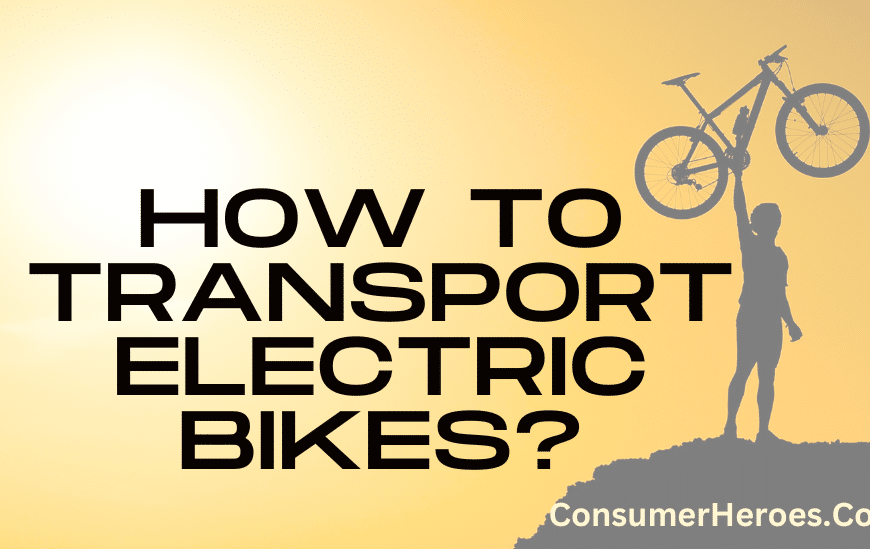E-bikes, or electric bicycles, are becoming increasingly popular around the world. These bikes are similar to traditional bicycles, but they are equipped with an electric motor and a battery that helps to power the bike. The electric motor provides assistance to the rider, making it easier to pedal and allowing them to travel further and faster than they would on a traditional bicycle.
One of the main benefits of e-bikes is that they are environmentally friendly. They produce zero emissions, which means that they do not contribute to air pollution or climate change. Additionally, they are a more sustainable mode of transportation than cars or motorcycles, as they require less energy to operate and can be charged using renewable energy sources such as solar power.
E-bikes are also an affordable and convenient way to get around. They are less expensive than cars or motorcycles, and they can be used to travel short distances without the need for a driver’s license or insurance. They are also easy to park and can be stored in small spaces, making them a great option for people who live in cities or have limited storage space.
What are E Bikes?
E-bikes, also known as electric bicycles, are bicycles that are equipped with an electric motor, battery, and controller. The electric motor assists the rider’s pedaling, making it easier to ride up hills or against headwinds. E-bikes are becoming increasingly popular as a mode of transportation due to their convenience, efficiency, and environmental friendliness.
E-bikes come in various styles, including road bikes, mountain bikes, and commuter bikes. They can have different levels of assistance, ranging from low to high, and can be classified as either pedal-assist or throttle-assist. Pedal-assist e-bikes require the rider to pedal in order to activate the motor, while throttle-assist e-bikes can be propelled solely by using the throttle.
One of the main advantages of e-bikes is their ability to cover longer distances with less effort compared to traditional bicycles. They are also a great alternative to cars for short to medium distance trips, reducing traffic congestion and emissions. E-bikes are also a great way to get exercise while commuting to work or running errands.
It is important to note that e-bikes are subject to regulations and laws that vary by country and state. In some areas, e-bikes may require a license or registration, and there may be restrictions on where they can be ridden. It is important for riders to familiarize themselves with the laws in their area before riding an e-bike.
Overall, e-bikes offer a convenient and eco-friendly alternative to traditional bicycles and cars. With their increasing popularity and advancements in technology, it is likely that e-bikes will continue to play an important role in transportation in the future.
The Origin of E Bikes
Electric bikes, also known as e-bikes, have become increasingly popular in recent years. These bikes have a motor that assists the rider’s pedaling efforts, making it easier to ride longer distances or up hills. But where did the idea for e-bikes come from?
The first electric bicycles were developed in the late 19th century, around the same time as the first gasoline-powered motorcycles. However, it wasn’t until the 1990s that e-bikes began to gain wider popularity. In 1993, a company called Yamaha introduced the first commercially successful e-bike, the PAS (Power Assist System).
Since then, e-bikes have continued to evolve and improve. Today, there are a wide variety of e-bikes available, from foldable commuter bikes to high-powered mountain bikes. They are used for everything from commuting to work to touring long distances.
One reason for the growing popularity of e-bikes is their environmental friendliness. They produce no emissions and are much more energy-efficient than cars or motorcycles. Additionally, they can be a more cost-effective mode of transportation, especially for short trips.
As technology continues to improve, it’s likely that e-bikes will become even more advanced and widespread. With their many benefits, it’s easy to see why they are becoming an increasingly popular mode of transportation.
Types of E Bikes
Pedal Assist
Pedal assist e-bikes are the most common type of e-bike. They work by providing an electric boost to the rider’s pedaling. The motor is activated when the rider starts pedaling and stops when the rider stops pedaling. The amount of assistance provided by the motor can be adjusted by the rider, usually through a handlebar-mounted control.
Pedal assist e-bikes are great for riders who want to get some exercise but need a little help on hills or when riding into the wind. They are also popular among commuters who want to arrive at work without breaking a sweat.
Throttle On Demand
Throttle on demand e-bikes, also known as “twist and go” e-bikes, are another type of e-bike. They work by providing power to the motor through a twist grip throttle, similar to the throttle on a motorcycle. The rider does not need to pedal to activate the motor.
Throttle on demand e-bikes are great for riders who want to cruise around without pedaling, or for riders who have limited mobility and cannot pedal for extended periods of time. However, they are not as efficient as pedal assist e-bikes and typically have shorter battery life.
In summary, there are two main types of e-bikes: pedal assist and throttle on demand. Pedal assist e-bikes are great for riders who want to get some exercise but need a little help, while throttle on demand e-bikes are great for riders who want to cruise around without pedaling.
Components of an E Bike
E-bikes or electric bikes are bicycles that have an electric motor and battery to assist the rider. These bikes have become increasingly popular in recent years due to their ability to make cycling easier and more accessible. In this section, we will discuss the main components of an e-bike.
Motor
The motor is the heart of an e-bike. It is responsible for providing assistance to the rider. E-bike motors are usually located in the center of the bike’s frame, in the rear hub, or in the front hub. The power of the motor is measured in watts, and the higher the wattage, the more powerful the motor. E-bike motors are usually categorized as either pedal-assist or throttle-assist. Pedal-assist motors only provide assistance when the rider is pedaling, while throttle-assist motors can be activated without pedaling.
Battery
The battery is another essential component of an e-bike. It provides power to the motor and determines the range of the bike. E-bike batteries are usually located on the frame, either behind the seat post or on the down tube. The capacity of the battery is measured in watt-hours (Wh), and the higher the watt-hour rating, the longer the battery will last. E-bike batteries can be charged using a standard wall outlet, and most batteries take around 4-6 hours to fully charge.
Controller
The controller is the brain of an e-bike. It connects the motor and battery and regulates the power output. The controller also allows the rider to adjust the level of assistance provided by the motor. E-bike controllers are usually located on the handlebars and have an LCD screen that displays information such as speed, distance, and battery level.
Pedal Sensor
The pedal sensor is a small device that detects when the rider is pedaling and sends a signal to the motor to provide assistance. The sensor is usually located near the bottom bracket of the bike. E-bikes can have different types of pedal sensors, including cadence sensors, torque sensors, and combined sensors. Cadence sensors detect the speed at which the rider is pedaling, while torque sensors measure the force applied to the pedals. Combined sensors use both methods to provide a more natural riding experience.
In summary, an e-bike has four main components: the motor, battery, controller, and pedal sensor. These components work together to provide assistance to the rider and make cycling easier and more accessible.
Benefits of Using E Bikes
Eco-Friendly
E-bikes are a great alternative to traditional gas-powered vehicles. They are eco-friendly and produce zero emissions, which means they don’t contribute to air pollution and global warming. E-bikes are powered by batteries that can be recharged using renewable energy sources like solar and wind power. This makes them an excellent choice for people who want to reduce their carbon footprint and protect the environment.
Health Benefits
E-bikes are not only good for the environment but also for your health. They provide a low-impact workout that can improve cardiovascular health, muscle strength, and flexibility. E-bikes allow riders to go further and faster than traditional bikes, which means they can get more exercise in less time. They are also great for people who have joint problems or other health issues that make traditional biking difficult.
Economical
E-bikes are a cost-effective mode of transportation. They are cheaper to buy and maintain than traditional gas-powered vehicles. They also require less maintenance than traditional bikes since they have fewer moving parts. E-bikes can save riders money on gas, parking, and other transportation expenses. They are an excellent choice for people who want to save money while still enjoying the benefits of cycling.
In summary, e-bikes are an eco-friendly, healthy, and economical mode of transportation. They provide a low-impact workout, reduce carbon emissions, and save riders money on transportation expenses.
Drawbacks of E Bikes
Initial Cost
One of the main drawbacks of e-bikes is their initial cost. Compared to traditional bicycles, e-bikes are more expensive due to the added technology and components. The average cost of an e-bike can range from $1,000 to $5,000 or more depending on the brand, model, and features. This can be a significant investment for some people, especially if they are used to purchasing traditional bicycles for a fraction of the cost.
Maintenance
E-bikes also require more maintenance than traditional bicycles. The added technology and components such as the motor, battery, and controller require regular maintenance to ensure optimal performance. This can include replacing worn-out parts, tuning the motor and controller, and ensuring the battery is functioning properly. The cost of maintenance can add up over time and may be a deterrent for some people.
In addition, finding a qualified mechanic who is knowledgeable about e-bikes can be challenging. Not all bike shops have the expertise to work on e-bikes, and some manufacturers may require servicing to be done by authorized dealers. This can limit the options for owners who need repairs or maintenance.
Overall, while e-bikes offer many benefits such as assisted pedaling and increased speed, they also have some drawbacks such as the initial cost and maintenance requirements. It’s important for potential buyers to weigh the pros and cons before making a purchase decision.
E Bikes Legislation
E-bikes are subject to different regulations depending on the country or state. In the United States, e-bikes are regulated by the Consumer Product Safety Commission (CPSC) and the Department of Transportation (DOT). The CPSC regulates e-bikes as consumer products, while the DOT regulates them as vehicles.
In general, e-bikes are classified into three categories based on their maximum speed and power output. Class 1 e-bikes have a maximum speed of 20 mph and a motor that provides assistance only when the rider is pedaling. Class 2 e-bikes have a maximum speed of 20 mph and a motor that can be used to propel the bike without pedaling. Class 3 e-bikes have a maximum speed of 28 mph and a motor that provides assistance only when the rider is pedaling.
The regulations for e-bikes vary from state to state in the United States. Some states, such as California and New York, have their own laws regulating e-bikes. Other states follow the federal regulations set by the CPSC and DOT.
In Europe, e-bikes are subject to the regulations set by the European Union. The EU has classified e-bikes into four categories based on their maximum speed and power output. Class 1 e-bikes have a maximum speed of 15.5 mph and a motor that provides assistance only when the rider is pedaling. Class 2 e-bikes have a maximum speed of 15.5 mph and a motor that can be used to propel the bike without pedaling. Class 3 e-bikes have a maximum speed of 28 mph and a motor that provides assistance only when the rider is pedaling. Class 4 e-bikes have a maximum speed of 28 mph and a motor that can be used to propel the bike without pedaling.
In summary, e-bike legislation varies depending on the country or state. It is important for e-bike riders to be aware of the regulations in their area to avoid any legal issues.
Tips for Choosing an E Bike
When it comes to choosing an e-bike, there are a few factors to consider. Here are some tips to help you make the right choice.
Consider Your Needs
Before purchasing an e-bike, it’s important to think about your specific needs. Here are some questions to ask yourself:
- What type of terrain will you be riding on?
- How far do you plan on traveling on your e-bike?
- Do you need to carry cargo or passengers?
- What is your fitness level?
Answering these questions will help you determine what type of e-bike is best for you. For example, if you plan on riding long distances, you may want to consider a bike with a larger battery. If you need to carry cargo, a cargo e-bike may be the best option.
Budget
E-bikes can range in price from a few hundred dollars to several thousand dollars. It’s important to set a budget before you start shopping. Keep in mind that while a more expensive e-bike may have more features, it may not always be necessary.
When setting your budget, consider the following:
- How often will you use the e-bike?
- How long do you plan on keeping the e-bike?
- Are there any additional accessories or features you require?
Test Ride
Before making a final decision, it’s important to test ride the e-bike. This will give you a better understanding of how the bike handles and feels.
When test riding, pay attention to the following:
- How does the bike handle on different types of terrain?
- How does the motor assist feel?
- Is the bike comfortable to ride?
By test riding the e-bike, you can ensure that it’s the right fit for you.
Conclusion
E-bikes are a rapidly growing segment of the bicycle industry, offering a variety of benefits to riders. They are a great option for those who want to commute to work, run errands, or just enjoy a leisurely ride without the need for excessive physical exertion.
One of the most significant advantages of e-bikes is their ability to reduce the environmental impact of transportation. By using electric power instead of gasoline, e-bikes emit zero emissions, making them a more sustainable option for those who are environmentally conscious.
E-bikes also provide a more accessible option for those who may not be able to ride traditional bicycles due to physical limitations. With the assistance of an electric motor, riders can tackle hills and headwinds with ease, making cycling a more inclusive activity.
Overall, e-bikes offer a convenient, sustainable, and accessible mode of transportation that is becoming increasingly popular among riders of all ages and abilities. As technology continues to improve, we can expect to see even more innovative features and designs in the e-bike market in the years to come.








It’s great that you pointed out how e-bikes are not only good for the environment but also for your health. I do not want to use my car every day, so I am now looking for a different mode of transportation. So with that in mind, I am thinking of checking out an e-bike seller.
Glad we could help you out, Luke.